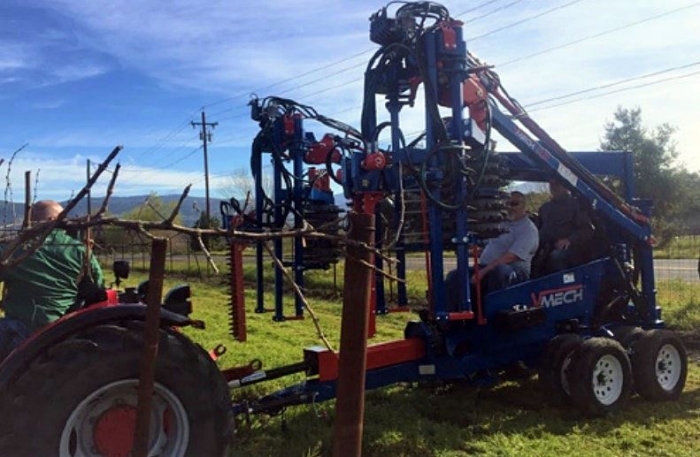Technology is Transforming Winemaking
The benefits and challenges of vineyard mechanization
2024-02-29

In the heart of California's rolling vineyards, an age-old practice is undergoing a seismic shift. Viticulture, the cultivation of grapevines, is stepping boldly into a new era, one where the traditional reliance on manual labor is being challenged by the relentless march of technology and the imperative of efficiency. As wine regions across the globe grapple with rising labor costs and workforce shortages—issues exacerbated by the global pandemic in 2020—the industry is turning to mechanization, not just as a stopgap, but as a forward-looking solution to sustain and enhance the art of winemaking.
For centuries, the care of vineyards has been a labor of love and, quite literally, labor-intensive. Tasks such as pruning, canopy management, and harvesting have traditionally required the skilled hands of numerous workers. These activities are not only laborious but are critical for the successful cultivation of quality grapes. Yet, the landscape of viticulture is being reshaped by a compelling blend of economic necessity and technological innovation.
The mechanization of vineyards isn't a novel idea; however, its adoption has surged in recent years. Economic pressures coupled with advancements in knowledge and equipment have encouraged vintners to embrace machines capable of performing everything from mechanical pruning to harvesting, leaf removal, and berry thinning. Leading the charge, academic institutions and equipment manufacturers have been pivotal in developing mechanical solutions for nearly every vineyard task imaginable.
The Benefits and Challenges of Mechanization
The advantages of mechanization are multifaceted. Firstly, it significantly reduces the reliance on manual labor for seasonal tasks, a boon in times of labor scarcity. Yet, the extent of this reduction varies, influenced by factors like the region, grape variety, and the number of practices that can be mechanized. Additionally, mechanization requires a leaner, more specialized workforce adept in decision-making based on data and information.
Designing a vineyard with mechanization in mind is crucial, starting from soil uniformity within blocks to the selection of rootstock, grape variety, and trellis system design. Proper drainage is vital as equipment access and operation are hindered in waterlogged conditions. Considerations also include equipment availability, appropriate row and within-row spacing, and headland size.
Cutting-Edge Pruning Techniques
Winter pruning, one of the most labor-intensive vineyard tasks, represents a significant portion of operational costs. Here, mechanization can make a profound difference, with mechanical pruning strategies potentially saving between 60-80% of labor costs per acre. Similarly, canopy management has seen significant advancements, with mechanized implements fulfilling all seasonal canopy requirements.
Perhaps the most visible triumph of vineyard mechanization is mechanical harvesting. Capable of collecting grapes faster and with fewer people, it's a crucial advantage when time and labor are in short supply. In the United States, around 90% of wine grapes are now harvested mechanically, underscoring the efficacy and importance of this technology.
Pioneering Pruning Methods
Vineyard mechanization has given rise to several innovative pruning methods, each with its own set of pros and cons. From minimal pruning, which focuses on high yield production despite its challenges, to more sophisticated techniques like box-pruning, hedger bar pruners, rotary and drum pruners, and combination and sprawl pruners, the choice of method depends on the vineyard's specific conditions and the winemaker's goals.
Transitioning to mechanized vineyards isn't without its hurdles. It demands substantial investment in technology and training, alongside meticulous planning to ensure vineyard design aligns with available machinery. Yet, the potential benefits—increased efficiency, cost savings, and the ability to maintain high-quality grape production in a changing labor market—are compelling. As the wine industry evolves, mechanization will undoubtedly play a pivotal role in shaping the future of viticulture, ensuring that this ancient practice continues to thrive in the modern era.
Mechanization of Pruning, Canopy Management, and Harvest in Wine Grape Vineyards DOI: http://dx.doi.org/10.5344/catalyst.2021.20011
Founded in 2007, Vinetur® is a registered trademark of VGSC S.L. with a long history in the wine industry.
VGSC, S.L. with VAT number B70255591 is a spanish company legally registered in the Commercial Register of the city of Santiago de Compostela, with registration number: Bulletin 181, Reference 356049 in Volume 13, Page 107, Section 6, Sheet 45028, Entry 2.
Email: [email protected]
Headquarters and offices located in Vilagarcia de Arousa, Spain.